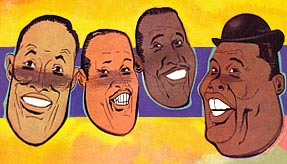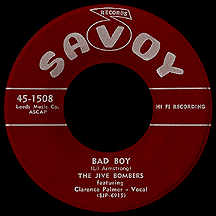THE JIVE BOMBERS
Bad Boy
Lil Armstrong's 1936 recording of "Brown Gal" was a favorite of late-'30s vocal group The Palmer Brothers, who performed the song for many years, recorded it a few times (updating it a bit with each attempt), and finally scored a hit more than 20 years after the original had been released on Decca Records. Memphis-born Lillian Hardin became Louis Armstrong's second wife in 1924 during his time as second cornet player with King Oliver's Jazz Band (Oliver being a cornetist as well). They divorced some 14 years later after she had become an artist in her own right, using her husband as an "in" to the business through involvement in a number of Satchmo's early musical masterworks. She kept his recognizable last name for the remainder of her career.
By the time "Brown Gal" came out, Lil was a seasoned songwriter, singer and pianist. The self-descriptive song was cowritten with Avon Long, a singer and dancer at the Cotton Club in Harlem during the mid-'30s who later appeared on Broadway in a number of musicals including the first revival of Porgy and Bess in 1942. During the 1970s he landed parts in some high-profile films including The Sting, Harry and Tonto and the 1979 TV miniseries Roots: The Next Generations (playing Chicken George, the role made famous by Ben Vereen in the original Roots two years earlier).
Dick, Ernest and Clarence Palmer of Pawtucket, Rhode Island, sang backup for jazz piano pioneer Earl Hines around 1935, later gaining steady work with top-flight bands led by Count Basie and "Hi-De-Ho" man Cab Calloway. "Blues in the Night," a hit for Cab in 1942, credited the Palmer Brothers on the label of the Okeh 78. They were also known as The Cabaliers during part of their time with Calloway's band. By the end of the decade, Dick and Ernest opted to leave the music business while Clarence continued, joining The Sparrows (a different group than the doo wop Sparrows of the '50s). Sax blaster Al Sears released a version of "Brown Boy" on Coral featuring the Sparrows with Palmer's lead vocal; the label lists Clarence as the song's composer, perhaps due to some rewriting of the lyrics (Lil's '...brown girl, chocolate girl!' being unsuitable for a male-perspective interpretation), yet the song is essentially the same as Armstrong's original.
Clarence, it seems, had been performing the song with the Palmer Brothers ever since "Brown Gal" had first appeared. His vocal delivery even resembled that of Louis Armstrong, an apparent influence, but that would change as he found his own sound. He didn't give up on "Brown Boy," recording it again in 1952 with Sonny Austin's group The Jive Bombers, a version that sounded closer to what later became the most famous rendition of the song. The Bombers went through some personnel changes over the next few years; by 1956 the foursome consisted of Palmer, Earl Johnson and former tap dancers Al Tinney and brother William "Pee Wee" Tinney. Manager Cliff Martinez brought them to the attention of Herman Lubinsky, owner of Savoy Records.

Right off the bat, the guys waxed yet another version of Palmer's favorite tune during their first Savoy session in late 1956. The lyrics underwent the most drastic revision this time around; the ethnicity was neutralized by changing the title to "Little Bad Boy," perhaps in an attempt to capture a larger audience. Despite the changes, Lil Armstrong's writer credit was restored, though Avon Long's name was curiously absent. By the time the record was released, it had been shortened to "Bad Boy" and the label credited Palmer as lead singer (the uptempo "When Your Hair Has Turned to Silver" on the flip side credited the lead vocal to Pee Wee Tinney).
Clarence used a new trick this time around, purposely affecting a stutter not found on earlier versions: 'I'm just a bad boy, la-la-la-la-la-la-la-la-la-la-la-LA-LA-LA-LA-LA-LA-la-la-la-la-la-la...' and with that the lyrics were rendered less noticeable when dominated by Palmer's la-fest. Regardless of the lyrical changes and updated sound, the recording still had a 1940s flavor, but that didn't stop it from breaking onto the charts in February 1957 and working its way into the top 40 the following month while also making an impact on the Most Played R&B in Juke Boxes chart (itself a soon-to-be-defunct '40s relic). For listeners, "Bad Boy" was and is an irresistible indulgence.
Nevertheless, landing a follow-up hit proved hopeless. Four more Savoy singles were released, all of the A sides containing Palmer's new trademark 'la-la-la' hook, each a little more tedious than the last. Some, like "Cherry," were nearly exact copies of the hit single. Starting with that third effort the label identified the act as Clarence "Bad Boy" Palmer and the Jive Bombers, exposing a degree of desperation. As a one-time gimmick, it was brilliant; as a formula for future success, it was something of a curse...unless, of course, you consider how much mileage an act can get out of one hit record. Palmer had spent a couple of decades performing "Brown Boy," followed by another couple of decades reliving the one-shot success of his 1957 hit "Bad Boy."


